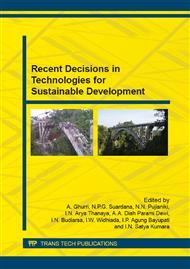p.215
p.223
p.229
p.233
p.239
p.246
p.253
p.260
p.264
The Influence of Austenisation Temperature and Holding Time on Mechanical Properties, Scale Thickness, and Microstructure in Alloy Steel
Abstract:
The application of steel products have been widely used and various research have been developed to find a good and appropriate quality of steel and can be produced in the country without have to be imported, for example alloy steels. One of the alloy steels that have been constantly developed is Ni-Cr-Mo alloy steel with additional nickel, chromium and molybdenum which can increase hardness, tensile strength, ductility and toughness. The effect during the production process is at the heating process that causes the formation of iron oxide layer (scale) and the loss of steel weight. Therefore, the selection of heat treatment methods and techniques are required to increase the mechanical properties of steel, such as hardness, tensile strength, and toughness, with the scale is about <5% of steel weight. In this research, the heat treatment was carried out at austenisation temperature of 800°, 850°, 900°C and at holding time of 20, 40, 60 minutes, then followed by a rapid cooling (quenching) to improve the mechanical properties of hardness. This research also tested the mechanical properties of steel that consist of hardness test and impact test, and metallographic observation that consist of micro structure observation and scale thickness observation. The micro structure from heat treatment process is martensite, it is due to a rapid cooling (quenching) that rapidly change the austenite phase into martensite. The data showed the highest hardness is 588.35 HVN at 850°C of temperature and 60 minutes of holding time, 8.5 Joules of impact energy, and 91.5 μm of scale thickness. While the lowest hardness is 539.34 HVN at 800°C of temperature, 5 Joules of impact energy, and 47.81 μm of scale thickness.
Info:
Periodical:
Pages:
239-245
Citation:
Online since:
July 2015
Authors:
Price:
Сopyright:
© 2015 Trans Tech Publications Ltd. All Rights Reserved
Share:
Citation:


